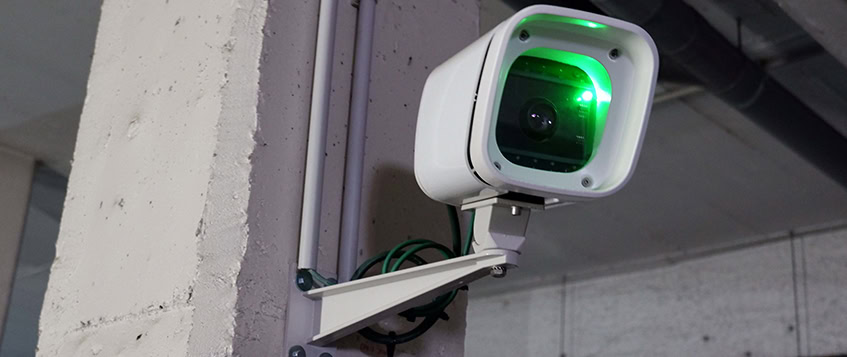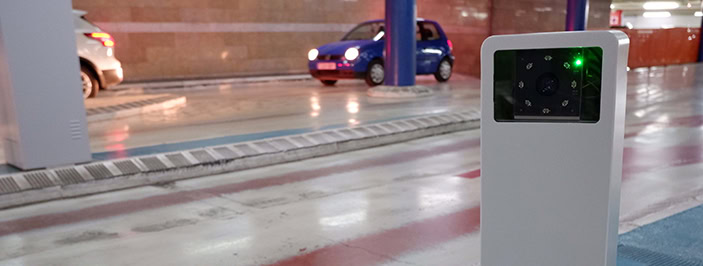By Sindhu Rao
IN MONTGOMERY COUNTY, MD., the Department of  Transportation’s (MCDOT) Division of Parking Management has served the parking lot districts (PLDs) of the Washington, D.C. suburbs of Bethesda, Silver Spring, and Wheaton for more than 60 years with thoughtful parking management techniques.
Transportation’s (MCDOT) Division of Parking Management has served the parking lot districts (PLDs) of the Washington, D.C. suburbs of Bethesda, Silver Spring, and Wheaton for more than 60 years with thoughtful parking management techniques.
Charged with addressing on- and off-street parking needs while supporting economic and transportation-related initiatives, the PLDs continually implement new parking management and operations solutions to enhance the competitiveness of these traditional and urban environments. The PLDs receive no direct government subsidies and are responsible for generating sufficient revenue to cover capital, operational, and debt service costs. Additionally, a certain amount of PLD funds are transferred to the county for the promotion of transit benefits, streetscape and lighting improvements, and other public amenities.
Organizational Structure
MCDOT’s Division of Parking Management is responsible for the administration of the county’s three PLDs. The division’s mission is to promote economic growth by offering sufficient parking, encouraging efficient transportation mode choice through a careful balance of parking rates and supply, and developing parking management strategies to maximize the usage of available parking.
The PLDs are a single administrative entity, giving it full control over on- and off-street parking management, regulatory and compliance coordination, and customer service. As an enterprise fund, the PLDs must generate enough revenue on an ongoing basis to not only be self-sufficient, but also to transfer millions of dollars to transit funds, urban districts, and the county’s general reserve every year.
The division governance structure is organized into four sectional units: administrative management, financial management, engineering and capital project management, and parking operations. Their roles are divvied up in the following ways:
- The administrative management section manages the planning, information technology, and customer and administration services staff to optimize organizational effectiveness. The section plans for the strategic redevelopment of PLD real property. The planning team leads the division’s innovation initiatives and plans for growth in the PLDs through short-term demand studies and long-term strategic plans.
- The financial management section has overall responsibility for recording and reconciling all revenue, the management of the encumbrance and invoice payment process, the revenue bond debt, and budget. In 2018, the section was responsible for managing program-wide revenue of nearly $38 million.
- The engineering and capital project management section provides engineering and project management for the design and construction of new parking facilities. The program ensures the preservation and structural integrity of existing parking facilities. It also provides services such as snow and ice removal; housekeeping services; equipment maintenance for elevators, electrical, and HVAC systems; and groundskeeping care.
- The parking operations section is responsible for collecting and processing parking revenue from the many methods of payment offered by the division. It is also responsible for managing the parking citation database, providing onsite security, and overseeing the appeal process for parking tickets.
Biennial Customer Service Survey
As bounded by Montgomery County government bylaws, the Division of Parking Management is required to conduct a parking customer service survey every two years to gauge customers’ perception of the public parking system’s performance. The division hires a consultant to administer the survey, ensuring it is completed in an independent manner. The survey targets two subgroups—permit holders and visitors—and offers those customers an opportunity to provide feedback on a wide range of parking issues. The survey results are used by MCDOT staff to measure the division’s performance. In the most recent survey, visitors and permit holders gave their highest marks to the conditions of facilities, safety and security, and convenience to destination. Overall satisfaction with the PLD’s facilities was high, with an average rating of 4.7 out of 5.
Recent Accomplishments and Initiatives
The county recently became one of the first jurisdictions in the U.S. to partner with two mobile payment vendors. The two-vendor mobile payment system was phased in during six months and is now available at more than 10,000 meters throughout the county. By offering two choices, MCDOT is providing greater flexibility and convenience for parkers.
Another technology adopted by the division is a digital parking guidance system, which offers real-time message signs outside and inside garages to direct people to available parking. This information is published to websites and mobile applications as well. The division’s electric vehicle (EV) infrastructure overview plan addresses the need and pathway for installing electric-vehicle charging stations in PLD facilities. To date, 16 charging stations that can serve 32 vehicles system-wide are operational with plans to install additional stations.
Another positive change the division made in its parking operations is an upgraded lighting system in each of the division’s 20 garages. The new high-output lamps are not only brighter but have saved the division around 20 percent in energy-related expenditures per facility.
Finally, with its partnership with Zipcar, the division has been a leader in promoting the usage of car-share. The division has more than 30 car-share spaces in a mixture of lots, garages, and on-street. To promote the visibility of car-share and encourage MCDOT’s alternative transportation objectives, the division has located the on-street car-share spaces near vibrant retail centers.
Additional initiatives implemented recently include a new residential permit program using mobile license plate recognition (LPR) enforcement, modernization of four parking facilities from single-space parking meters to master meters, a variable parking policy program, a dynamic parking map embedded on the county’s website, the county’s first “cycle-track” bike lane, and revamping the Ad Valorem tax program that helps fund the PLDs.
To support the general tax base and improve pedestrian experience, the division has repositioned land by developing three surface lots into mixed-use centers. As part of a public-private partnership, the division transformed an existing 200-space parking lot in downtown Bethesda into a 950-space subterranean parking garage with first-floor retail and a multi-story residential building above. The publicly owned and operated garage was needed to release pressure off a nearby garage that frequently operated at capacity during peak hours. The project included wider sidewalk space, a pedestrian cut-through connection to an adjacent trail, a public plaza, restaurants, and the addition of hundreds of residents within a short walk of a transit station.
Two other public-private partnerships are currently underway. In Wheaton, the division is redeveloping a 160-space parking lot; by 2020, it will have been converted into a 400-space underground garage with first floor retail, a town square, and a 310,000-square-foot office building above. And in Silver Spring, construction recently wrapped up on a 162-space underground public parking garage with a residential tower above and associated plaza on what was formerly the site of a county parking lot. Beyond these projects, the division is in various planning stages for the future redevelopment of additional PLD lots and garages.
Dual Vendor Mobile Payment System
Mobile payment technology is a win-win. For customers, it is a convenient cashless solution. For parking management agencies, it requires little financial investment or continual operating costs. As the second largest jurisdiction in the Washington metropolitan area, Montgomery County has a significant demand for parking from employees, residents, and visitors in its urban areas. In 2010, the division introduced a mobile payment solution to its payment ecosystem. The division partnered with MobileNOW, and success followed immediately with high adoption rates. Today, the program processes more than 150,000 parking sessions monthly and has generated over $30 million in revenue since its inception.
To build on this success, the county explored solutions to further increase mobile payment use for several reasons. First, mobile payment systems have minimal infrastructure requirements and limited ongoing operational costs and lack credit card processing fees. Benefits flow to customers too, including the ability to conveniently pay for parking, receive a text message when parking time is close to expiring, extend the parking session remotely, pay for only time parked, and track personal parking activity.
Second, the county serves a cross-jurisdictional consumer base. A substantial portion of MCDOT’s parking facility users come from outside the county. Consequently, these parkers are accustomed to using the mobile payment provider offered in their hometown, which may differ from Montgomery County’s. Wanting to avoid balancing multiple payment accounts, there’s a segment of the customer base that’s disinclined to register with the county’s vendor’s app. Therefore, to mitigate the downside of parkers eschewing mobile payment due to unfamiliarity with the county’s vendor, improving mobile payment access became a division priority.
Ultimately, the county decided to become one of the country’s first jurisdictions to provide customers with a choice of mobile payment vendors. The county wanted to capitalize on the opportunity to nudge customers in the mobile payment direction. The county issued a request for proposals in early 2017, and following the bidding process partnered with its existing vendor, MobileNOW, and a new vendor with a well-established presence in the Washington, D.C.-area market, ParkMobile.
Prior to the rollout, a few issues needed resolution. For example, the county needed to get both vendors on board with a sign package. To keep sign clutter to a minimum, it was apparent that both vendors’ branding would have to be integrated into the same signs. The county spearheaded the design process, contracted with a local graphic designer, and developed instructional signage to be installed in visibly prominent locations within garages. Both vendors provided feedback during the design process and approved final drawings. The result was a cohesive sign package that reduced visual clutter in parking facilities.
Another issue impeding a smooth deployment was enforcement complications. The county was challenged with integrating both vendors’ parking enforcement technology into a single software platform. MCDOT collaborated with the vendors’ IT teams for workable solutions, and the county’s enforcement officers are now able to view transaction data from each vendor on their handheld devices in real time.
Decals on meters inform customers of the mobile payment option. However, relinquishing space on meter heads exclusively to vendor decals could have negative future consequences if either vendor folded or did not meet contractual obligations. To work around this potential problem, the county configured a consistent meter layout with four distinct decals:
- MobileNOW’s decal displaying a QR code and space number.
- ParkMobile’s decal displaying a QR code and space number.
- A Montgomery County decal displaying the space number.
- A Montgomery County decal displaying a URL address directing patrons to the county’s website with mobile payment instructions.
This approach eases the transition if the partnership with one of the vendors were to end. That company’s decal could be removed or replaced without disrupting the mobile payment program.
By late 2017, the county began an incremental launch. A phased approach was adopted as staff was tasked with installing the four decals on more than 10,000 meters throughout the PLDs. By mid-2018 the launch was complete with 10 garages, 20 lots, and more than 2,300 on-street meters in the PLDs outfitted with dual vendor mobile payment capability. The county plans to expand the program to additional facilities, including pay-by-space environments.
Program Outcomes
Due to the widespread diffusion of mobile technology, consumers have come to expect convenience in many aspects of their lives. While the county has modernized the payment systems in several facilities, budgetary realities have prevented the county from modernizing the entire parking system. This has given rise to frustrated customers. Paying for parking with coins is a common pain point. Indeed, the dual vendor mobile payment system has provided MCDOT and its customers with tangible benefits and improved experience. For MCDOT, the system has proven powerful because it does not require new equipment or maintenance costs. For customers, it has aligned with the convenience that technology has brought elsewhere in their lives.
The county has access to a comprehensive web-based collection of reports from both vendors, enabling analyses of mobile payment activities. To benchmark success of the program, the county tracked mobile payment sessions and revenue per facility in the months leading up to the dual-vendor implementation and tracked sessions and revenue post-implementation. Since implementation of the dual vendor system, year-over-year total parking sessions increased over 20 percent and revenue by $1.3 million.
MCDOT plans to expand the dual vendor mobile payment system to additional parking facilities. The system is currently only available in facilities operated by single-space meters and pay-and-display environments. The county anticipates rolling out the dual vendor system in its pay-by-space garages and lots soon. With this impending expansion, MCDOT will reap further benefits, and greater convenience will flow to additional county parkers.
Read the article here.
SINDHU RAO is IT specialist III in the Division of Parking Management of the Montgomery Department of Transportation. She can be reached at sindhu.rao@montgomerycountymd.gov.








